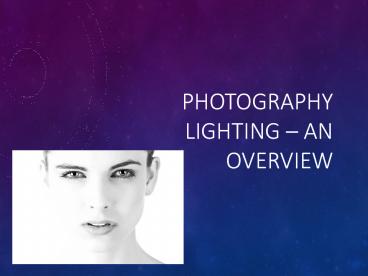Photography Lighting – An Overview - PowerPoint PPT Presentation
Title:
Photography Lighting – An Overview
Description:
Lighting assumes a critical part in photography. It can breathe life into a photograph, it can produce impacts, including astounding shadows or outlines – PowerPoint PPT presentation
Number of Views:193
Title: Photography Lighting – An Overview
1
Photography Lighting An Overview
2
- Lighting assumes a critical part in photography.
It can breathe life into a photograph, it can
produce impacts, including astounding shadows or
outlines, or it might have a particularly
negative impact by making unwanted glare and
reflections.
3
Hard and Soft Light
- This initial segment analyzes a standout amongst
the most fundamental issues the distinction
between shooting in a hard and delicate
photography lighting. - Hard light creates very much characterized, dark
shadows and has a tendency to start from a
separate light source, which is generally either
little or situated far away. By differentiating,
delicate light delivers either delicate shadows
or no shadows by any means.
4
(No Transcript)
5
- It can be produced from a few light sources, by
diffusing light utilizing some boundary (e.g. a
diffuser or even only a sheet of paper), or by
reflecting light off various surfaces, so the
subject is hit from different edges. - In normal lighting conditions, hard light is
delivered on a sunny day when there is
practically zero overcast cover, and when the sun
is high in the sky - which is something that is,
for the most part, to be kept away from,
especially by amateurs. Shooting in different
sorts of climate, e.g. dark days, foggy
conditions, or even where there is air
contamination, will create delicate light, as the
sun's beams are reflected or diffused by the
particles noticeable all around
6
Reflectors
- The activity of reflecting light will radically
transform the mirror into an auxiliary light
source. A wide range of things can be employed as
reflectors, regardless of whether shooting inside
or outside. These incorporate proficient
reflectors or just sheets of paper.
7
Diffusers
- In natural lighting conditions, mists are
excellent cases of diffusers. In artificial
lighting conditions, any semi-straightforward
material that diffuses or mollifies the light can
be utilized. Light shades are an excellent case
of light dispersion. When shooting, even a thin
white fabric can be employed.
8
Light power and Depth of Field
- When shooting a photograph, a particular measure
of light will be required by the camera to make a
photo on the advanced sensor. The ISO (or chip
affectability), the gap setting, and the screen
speed will decide the measure of light that is
required.
9
ISO
- This is a rating of the light affectability of
the computerized camera's sensor. In many
cameras, this will ordinarily go from 100-12800,
with these numbers connoting the level of
intensification that the sensor applies. Bringing
down the ISO settings will yield a photo with
less "clamor". - However, it will likewise require all the more
light, and consequently a more extended
presentation time. - Expanding the ISO setting will make the sensor
open up the light, subsequently enabling shots to
be taken in darker conditions. In any case,
higher ISO settings convey the downside of
delivering more commotion and prompting a photo
that will seem "grainy."
10
Shutter speed
- When taking a photo, the shade before the sensor
is opened to enable light to achieve it. The more
extended this screen is left open, the all the
more light will enter. - When shooting moving subjects, high screen speeds
are required to lessen the measure of development
amid the time that the shade is open. This will
empower 1) solidifying the question as it is shot
and 2) grasping hand-held shots.
11
Opening
- This is an opening through which light voyages.
The gap is changed utilizing a gadget called the
stomach. A littler gap permits less light through
the perspective and, then again, a bigger opening
enables all the more light to achieve the sensor.
Opening settings are called f/stops. The littler
numbers, (for example, f/1.0 to f/3.5) connote
the biggest gap opening and enable the most
measure of light to the sensor. On the other
hand, an estimation of f/22 will diminish the
opening and permit far less light to go through
the perspective. Every focal point has the other
scope of opening settings.
12
- Powered by INFOZUB































